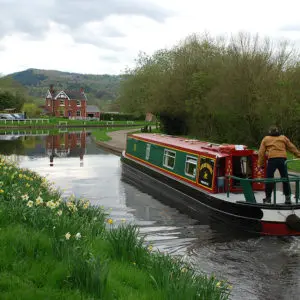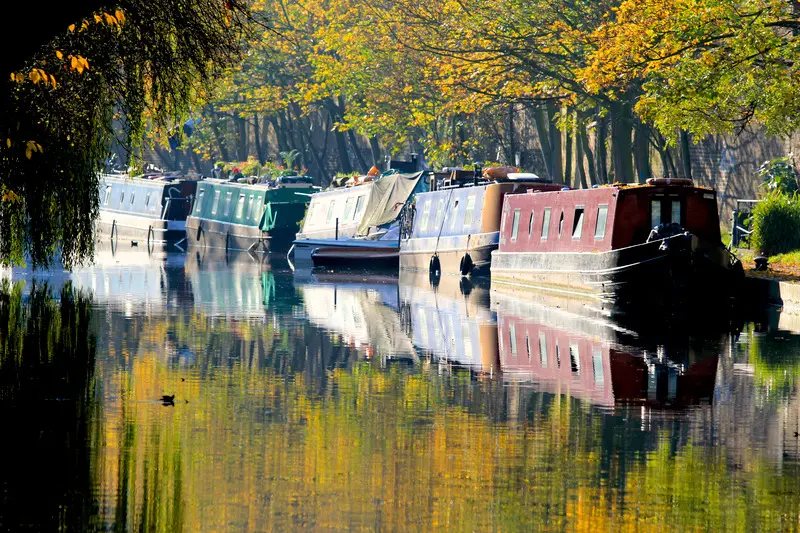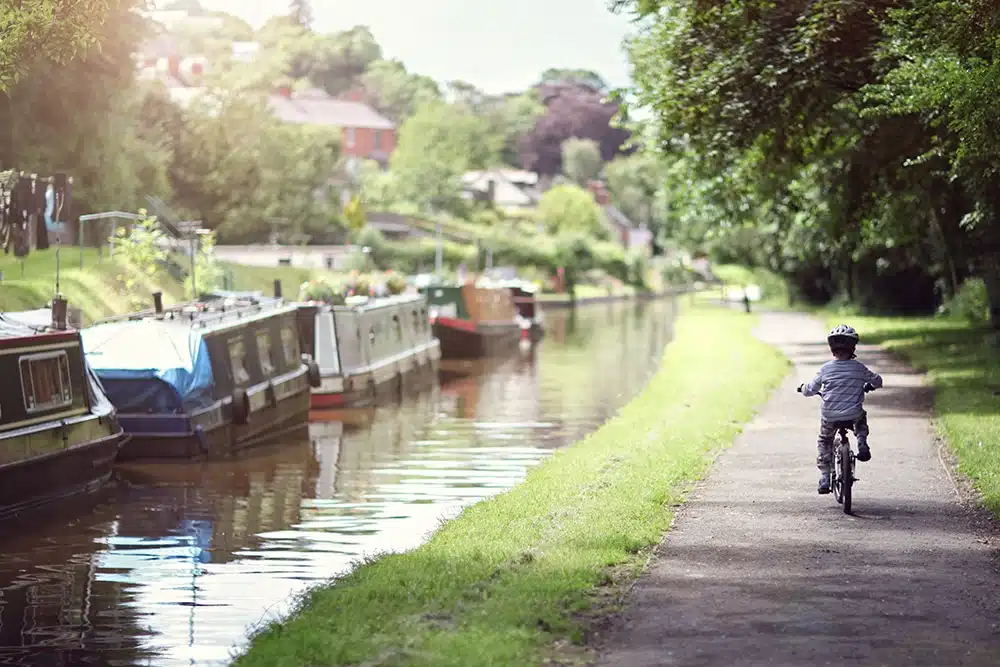At first, the Inland Waterways can seem a bit daunting, especially when people are using words you don’t understand!
However, we’re here to break down some of the most popular words that are used and explain what they mean.
Glossary
- Abreast – Alongside, side by side.
- Adrift – Anything broken away from moorings or fastenings.
- Aft – towards or near the stern.
- Air draught – The overall height of a vessel measured from the water line to the highest part.
- Anchor – Heavy iron or steel implement for chaining a boat to the sea or river bed.
- Anode – replaceable, large piece of metal that is fitted to the hull under the waterline.
- Aqueduct – A bridge which carries a waterway over a road or river.
- Blacking – A term for a protective coat of paint applied to hulls to inhibit rusting.
- Breach – Burst or collapse of a canal bank.
- Bulkhead – Upright panels that separate a boat into compartments
- Cavitation – Loss of thrust efficiency due to air being drawn into the propeller.
- Cockpit – Open area, usually set lower than surrounding side-decks.
- Cratch – Optional assembly over the fore-well of a narrowboat.
- Cut – Canal navigation or any artificial channel.
- Fender – Traditionally made of rope to protect the sides, stem and stern of a boat.
- Grab rail – A rail, usually fixed along edges of a narrowboat to give a secure handhold when moving along the deck.
- Grounding – Hitting the bottom of the waterbed or running hard aground
- Hatch – A horizontal opening in the deck.
- Keel – One or more parallel fins on the underside of the hull.
- Lock – The raising or lowering of a boat between changes in water levels.
- Moor – To secure a boat against the bank with lines to strapping stumps or mooring pins etc.
- Navigation lights – Lights required by various navigation authorities to be shown when cruising at night or when visibility is poor.
- Off-line mooring – Space away from the main line of canals such as in a marina or private cut.
- On-line mooring – Permitted berthing space alongside the towpath.
- Overflow – A weir set in the bank of a canal to take away any excess water and prevent flooding.
- Port – Left-hand side of a boat when looking forward.
- Port to port – The usual manner in which oncoming boats pass each other.
- Pram canopy – Cloth canopy fitted to the cockpit.
- Propeller – Spiral shaped blades which when rotated by the engine causes the boat to move.
- Starboard – When looking forward, the right-hand side of the boat.
- Stern line – Rope used for securing boat by stern dolly or T-stud to other things such as a mooring pin.
- Stern rail – An enclosed safety rail around the stern of a vessel.
- Swan’s neck – Name for the curved steel bar that connects the top of the rudder to the tiller.
- Siller – A lever against which the steerer pushes to direct the rudder and steer the boat.
- Tow path – The path by the side of the canal used by horses or men hauling boats.
- Weed-hatch – A watertight compartment with a removable lid in the stern of the boat, which provides access from deck level for clearing a fouled propeller.
- Weir – An overspill dam placed across a river or alongside a canal or by the sides of locks for regulating the depth of water.
There are many many more terms, but these are some of the most commonly used one’s.
So, now you know some nautical terminology, there are still a few more things you need to do and know about the waterways before setting off.
Here are a few things we are going to cover.
- Boat-handling
- Boat safety
- Rules of the Waterways
- Good boating etiquette
Boat-handling
Setting off
Start the engine, keep it in neutral and wait for a short period of time for the engine to warm up.
When ready to depart, untie both the front and back mooring ropes from the bank but leave the tied to the boat coiled up, ready for use next time.
If you have moored up on a river, do not forget to collect your mooring stakes and be sure to tidy them away securely after use.
As narrow-boats steer from the back of the boat, you will firstly need to check the area is free from boat traffic and then push the boat away from the bank, departing with the propeller deep in the water.
Once the boat is sitting straight in the water, go into forward gear and accelerate.
Under way
Across all the waterways, the rule is to always be on the right. You may find this to be no problem on wide waterways, but on most canals (unless there is another boat heading towards you) you should steer down the middle.
This is because it is likely to be shallow towards the edges.
When meeting another boat, simply keep to the right and pass each other on the left.
Don’t try to cut corners when going around bends as you risk collision or going aground.
Remember to go slowly and keep your eye out for other waterways users that may not see you.
Mooring
Slow the boat down until it has almost stopped entirely. Stop just a little short of where you want to moor up making sure your boat is straight.
Then, move forward very slowly pointing the boat towards the bank and use the reverse gear to stop the boat before the front hits the bank.
Then put the boat into neutral gear.
Be sure to moor in places you are allowed to and respect time limitations.
Locks
Locks can seem a little confusing at first, but it is just a series of step-by-step tasks.
A lock is a chamber with gates at either end. Opening or closing these gates will allow your boat to move up or down onto a new area of the waterway.
There are various types of locks, but they all work on the same principal.
When the lock gates are closed, you operate the sluices or paddles to allow water to get in or out.
Once the water level under your boat is the same as the level you are moving to, you can open the gates and move in or out of the lock.
Some locks are operated by lock-keepers and some you operate yourself. Check with your particular waterway to find out more details.
There are many other boat handling rules so be sure to read up on all of them as recommended by the Canal River Trust.
Boat safety
Slips, trips and falls.
This is one of the most common types of accident but falling from a boat can be a lot more serious.
Not only could you drown, you could hit your head, be crushed between a boat and the bank or even be dragged into a moving propeller.
We do not want to scare you, but these are all things that need thinking about so you will know how to avoid them at all costs.
So here are a few things you can do to avoid any accidents;
- Watch out for collisions and if you are going to have to bump, warn passengers to brace themselves.
- Keep your decks clear of ropes, mooring stakes or any other clutter.
- Don’t jump onto/off the boat when mooring.
- Wear non-slip deck shoes
Signs
There are many signs along the Waterways and we recommend you learn what each of them mean. They can be very handy when it comes to navigating around safely.
Collisions
Collisions with boats, bank or bridges are a common cause of injury.
Be sure to check the headroom for bridges and remember that bridge shapes vary and water levels rise and fall.
Be ready for strong flows at locks and other places where water is taken in or out of the waterway.
Sound your horn for several seconds as you approach blind corners and junctions.
Watch out for other waterways users such as canoes and dinghies.
Fire
Boat fires and explosions should not be taken lightly. These types of accidents can be fatal.
The bottled gas inside canisters used for cookers, fridges and heaters are heavier than air and if there is a leak will build up in the bottom of the boat. All it needs is a small spark and it will ignite the gas.
You should also be cautious when operating cookers and heaters as to avoid carbon monoxide poisoning.
We recommend checking your appliances regularly and fit a smoke and carbon monoxide detector suitable for use on boats and test it regularly.
Rules of the waterways
There are 8 main rules of the waterway
- Speed limits – the maximum speed on narrow canals is 4mph
- Overtaking – this will rarely need to happen but you should speak with the skipper and pass on the left
- Channel Markers – if there’s a channel you should stick to it
- Weirs – Do not pass close to any weirs. It can be extremely dangerous
- Giving way – if another boat is closer to a bridge or narrow section, wave them through and keep clear
- Passing dressers or works – Pass on the side that is showing a red or white light not the red light
- Navigation lights – It is recommended to not navigate at night but there is no strict rule to say you cannot.
If you decide to, however, you will need to have lights mounted to your boat; white lights for front and back, green lights for the right side and red lights for the left side. - Sound signals – To tell others what you plan on doing use the following;
- 1 blast for going to the right
- 2 blasts for going to the left
- 3 blasts for if you are trying to stop or go backwards
- 4 blasts with a pause then 1 blast for turning around to the right
- 4 blasts with a pause then 2 blasts for turning around to the left
- one extra long blast for several seconds to offer a warning at blind bend, tunnels and junctions.
Good boating etiquette
There are a lot more boating etiquette’s than there are actual rules. However, sticking to them will help make for a much more peaceful and less stressful time.
Environment/littering
It goes without saying that the waterways would not have the same aesthetics if they were full of litter and the wild life wouldn’t that depends on it would not like it too much either.
Do not throw any waste overboard. Litter can kill wildlife and can cause problems for other boaters too by getting tangled in their propellers. There are plenty of waste
disposal points at marinas and along the waterway, so just hold onto your litter until you can dispose of it safely.
Although recycling points are not universal at waste disposal points there are also plenty of public sites near waterways.
Do not dump oily water from your bilge into the water. Well maintained engines shouldn’t leak, so if this is becoming a recurring factor you may want to get your boat booked in to see a specialist.
Do not empty any sewage into the waterways. There are facilities for chemical or closed toilet systems at marinas and sanitary stations.
You are allowed to empty the waste water from your sink, shower, dishwasher and washing machine into the waterway. However, normal detergent and washing liquids have chemicals in them that are harmful to aquatic life. So we recommend using environmentally friendly products.
Boat usage
It is recommended that you only run your engine between 8am and 8pm so to not disturb other boaters.
Go slow before, during and after passing moored boats.
When mooring, make sure you haven’t left a large space that another boat cannot get into. This is especially true and very busy and popular areas.
Be sure to learn how long you can stay moored in one particular place and do not overstay.
Don’t block the towpath.
Respect the waterways and other users on it.
Helpful websites
We have supplied you with some basic information about the Inland waterways, but there are other websites that go into much further detail.
Here are a few websites that we recommend for further information on the Inland Waterways;
That’s about it from us. We hope you learned something new and now know more about what life on the waterways is like.
Want to keep up with all things Owatrol? Why not follow us on social media? You can find us on Facebook, Twitter, Instagram and Pinterest at @owatroluk or at the hashtag #owatroluk














